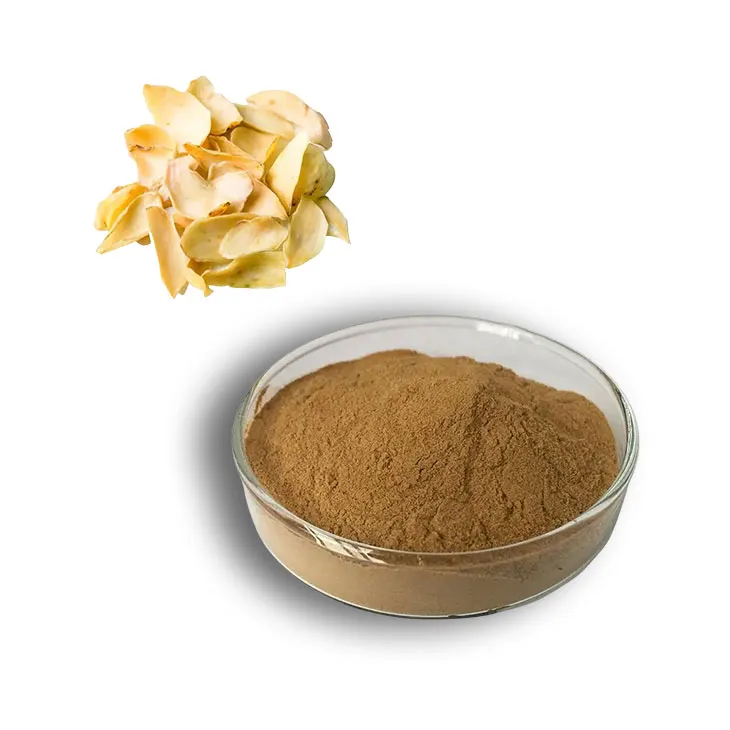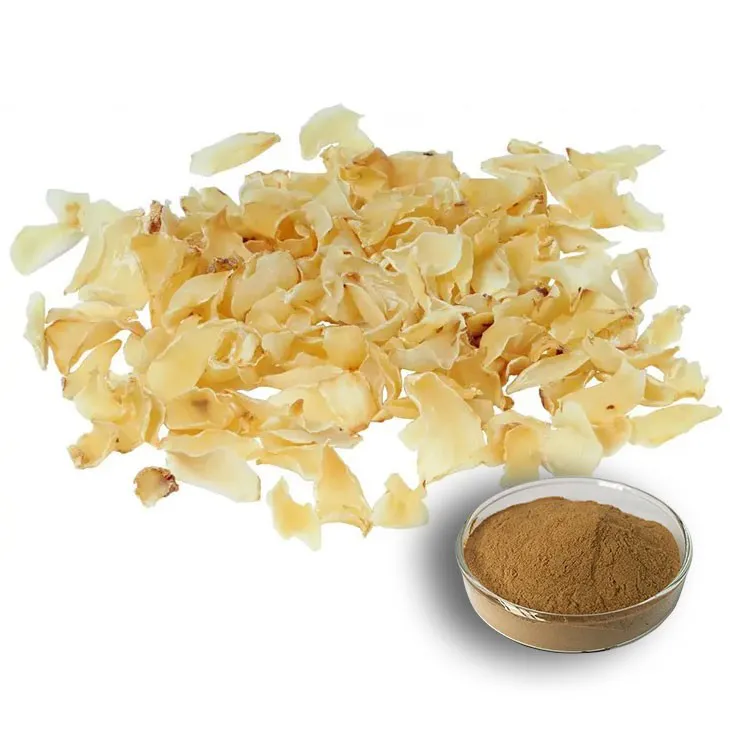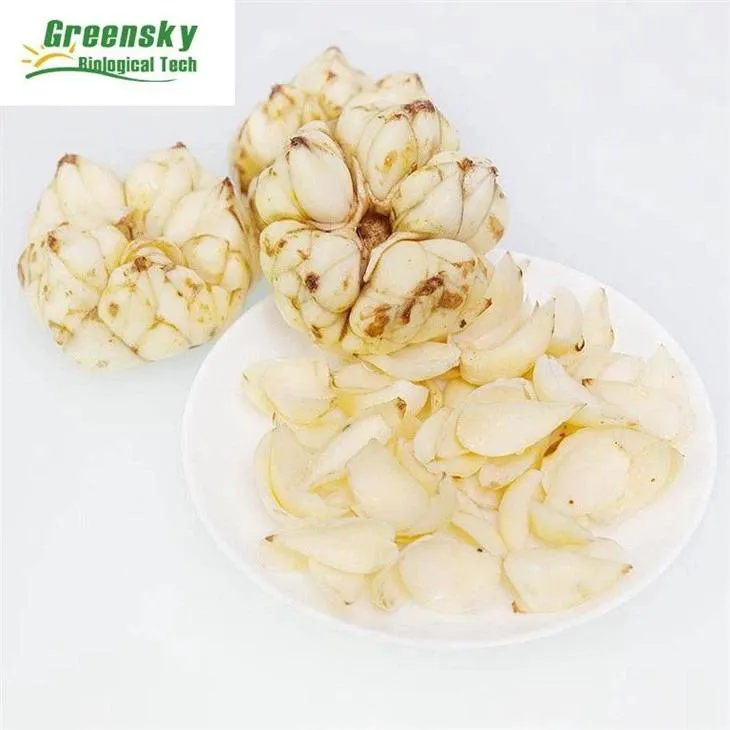- 0086-571-85302990
- sales@greenskybio.com
Extraction process of lily extract.
2024-11-27

1. Source of Lily Materials
The extraction of Lily extract commences with the careful selection of high - quality lily specimens. Lilies are known for their diverse species, and different species may have varying chemical compositions and potential applications. The most commonly used parts for extraction are either fresh flowers or bulbs.
- Fresh flowers: They are often preferred when the goal is to extract certain volatile compounds or delicate bioactive substances. Flowers are collected at the appropriate stage of bloom, typically when they are fully open but not yet starting to wilt. This ensures that the concentration of the desired compounds is at its peak.
- Bulbs: Bulbs are rich in various nutrients and bioactive compounds. They are usually harvested during the dormant season. This is important as it allows for maximum accumulation of the compounds within the bulb. For example, some lilies' bulbs may store significant amounts of polysaccharides during this time.

2. Initial Cleaning
Once the lily materials (either flowers or bulbs) are obtained, the next crucial step is the initial cleaning operation. This step is essential to remove any dirt, debris, or unwanted contaminants that may be present on the surface of the lilies.
- For fresh flowers: The cleaning process involves gently rinsing the flowers under a slow stream of cool water. This helps to wash away any dust particles or small insects that might be clinging to the petals. Special care is taken not to damage the delicate flower structure, as any physical damage could potentially lead to the loss of some volatile compounds.
- For bulbs: Bulbs are first brushed gently to remove any loose soil. Then, they are soaked in a mild detergent solution for a short period. This helps to dissolve any stubborn dirt or waxy substances on the surface of the bulb. After soaking, the bulbs are thoroughly rinsed with clean water to ensure that no detergent residue remains, as detergent residue could interfere with the subsequent extraction process.

3. Dehydration
After the cleaning process, the lily is dehydrated in a gentle manner. Dehydration is a critical step as it helps to preserve the lily materials and prevent the degradation of their natural components.
- There are several methods for dehydration. One common method is air - drying. In this method, the lilies are spread out in a well - ventilated area, away from direct sunlight. The air - drying process is slow and allows the moisture to evaporate gradually. This slow process is beneficial as it minimizes the disruption of the internal structure of the lily and helps to retain the integrity of the bioactive compounds.
- Another method is low - temperature drying. This involves using a drying oven set at a relatively low temperature, usually between 30 - 40°C. This method is particularly suitable for larger quantities of lily materials. The low - temperature environment helps to prevent the overheating of the lilies, which could lead to the denaturation of proteins or the breakdown of other heat - sensitive compounds.

4. Extraction Techniques
For the extraction proper, a combination of techniques might be used. Each technique has its own advantages and is selected based on the specific requirements of the extraction process.
4.1 Ultrasonic - Assisted Extraction
One of the commonly used extraction techniques is ultrasonic - assisted extraction. Ultrasonic waves are used to disrupt the cell walls of the lily more effectively, allowing better access of the solvent (such as a mixture of water and organic solvents) to the internal components.
- The ultrasonic - assisted extraction process involves placing the dehydrated lily materials in a suitable extraction vessel along with the solvent. The extraction vessel is then placed in an ultrasonic bath or equipped with an ultrasonic probe.
- The ultrasonic waves create microscopic cavitation bubbles in the solvent. When these bubbles collapse, they generate intense local shockwaves and shear forces. These forces act on the cell walls of the lily, breaking them open and releasing the intracellular components into the solvent.
- The frequency and intensity of the ultrasonic waves can be adjusted according to the nature of the lily materials and the desired extraction efficiency. For example, a higher frequency may be more suitable for extracting smaller molecules, while a lower frequency may be better for larger compounds.
4.2 Solvent Extraction
Solvent extraction is another fundamental technique in the extraction of Lily extract.
- The choice of solvent is crucial. A common approach is to use a mixture of water and organic solvents. Water is often included as it can dissolve polar compounds present in the lily, such as certain polysaccharides and some water - soluble vitamins. Organic solvents, on the other hand, are used to extract non - polar or less polar compounds. For example, ethanol is a popular organic solvent for Lily extraction as it is relatively safe, has a good solubility for many bioactive compounds, and is easily removable during the purification process.
- The solvent extraction process typically involves soaking the lily materials in the solvent mixture for a certain period. This allows the solvent to penetrate the lily tissues and dissolve the desired compounds. The extraction time can range from a few hours to several days, depending on the nature of the compounds being extracted and the extraction conditions.
- After the extraction period, the mixture is filtered to separate the liquid extract (containing the dissolved lily compounds) from the solid residue of the lily materials.
4.3 Microwave - Assisted Extraction
Microwave - assisted extraction is also an option in the extraction of lily extract.
- In this technique, the lily materials are placed in a microwave - compatible extraction vessel along with the solvent. The microwave radiation is then applied to the vessel.
- Microwave radiation causes the molecules in the solvent and the lily materials to vibrate rapidly. This rapid vibration generates heat within the system, which in turn increases the solubility of the compounds in the solvent and accelerates the extraction process.
- Similar to ultrasonic - assisted extraction, the extraction parameters such as microwave power and extraction time need to be optimized according to the specific characteristics of the lily materials and the compounds to be extracted.

5. Purification of the Extract
After extraction, the extract is purified through methods like chromatography to separate the desired lily - derived compounds from other impurities. Purification is necessary to obtain a high - quality lily extract with a high concentration of the target compounds.
- Chromatography is a widely used purification method. There are different types of chromatography techniques that can be applied, such as column chromatography, high - performance liquid chromatography (HPLC), and gas chromatography (GC), depending on the nature of the compounds to be separated.
- In column chromatography, for example, the extract is loaded onto a column filled with a stationary phase (such as silica gel or an ion - exchange resin). The mobile phase (a solvent or a solvent mixture) is then passed through the column. Different compounds in the extract will interact differently with the stationary and mobile phases, causing them to move through the column at different rates. This results in the separation of the compounds.
- HPLC is a more advanced and precise chromatography technique. It uses a high - pressure pump to force the mobile phase through a tightly packed column. This allows for a more efficient separation of compounds, especially for complex mixtures. HPLC can also be coupled with detectors such as ultraviolet (UV) detectors or mass spectrometers to identify and quantify the separated compounds accurately.
- GC is mainly used for the separation and analysis of volatile compounds. The extract is first vaporized and then passed through a column in a gaseous state. The separation is based on the differences in the volatility and affinity of the compounds to the stationary phase.
6. Storage of the Final Lily Extract
The final lily extract is then stored under proper conditions to maintain its stability and potency.
- The storage conditions are highly dependent on the nature of the extract. In general, it is advisable to store the extract in a cool, dry place, away from direct sunlight. Exposure to heat, light, and moisture can cause the degradation of the bioactive compounds in the extract.
- For some lily extracts that are sensitive to oxidation, it may be necessary to store them under an inert gas atmosphere, such as nitrogen or argon. This helps to prevent the oxidation of the compounds and prolong their shelf - life.
- The extract can be stored in suitable containers. Dark - colored glass bottles are often preferred as they can block out most of the light. Additionally, proper sealing of the containers is essential to prevent the ingress of air and moisture.
FAQ:
What are the main sources of lily for extraction?
The main sources of lily for extraction are usually fresh flowers or bulbs.
Why is gentle dehydration important in the lily extract extraction process?
Gentle dehydration is important in the lily extract extraction process because it helps to prevent the degradation of the lily's natural components.
What is ultrasonic - assisted extraction and how does it work in lily extract extraction?
Ultrasonic - assisted extraction is a technique where ultrasonic waves are used. In lily extract extraction, it works by disrupting the cell walls of the lily more effectively. This allows better access of the solvent (such as a mixture of water and organic solvents) to the internal components.
How is the lily extract purified after extraction?
After extraction, the lily extract is purified through methods like chromatography. This method is used to separate the desired lily - derived compounds from other impurities.
What are the proper storage conditions for the final lily extract?
The proper storage conditions for the final lily extract are those that can maintain its stability and potency, but specific conditions may vary depending on the nature of the extract.
Related literature
- “The Extraction and Application of Lily Extracts in Cosmetics”
- “Study on the Optimization of Lily Extract Extraction Process”
- ▶ Hesperidin
- ▶ Citrus Bioflavonoids
- ▶ Plant Extract
- ▶ lycopene
- ▶ Diosmin
- ▶ Grape seed extract
- ▶ Sea buckthorn Juice Powder
- ▶ Fruit Juice Powder
- ▶ Hops Extract
- ▶ Artichoke Extract
- ▶ Mushroom extract
- ▶ Astaxanthin
- ▶ Green Tea Extract
- ▶ Curcumin
- ▶ Horse Chestnut Extract
- ▶ Other Product
- ▶ Boswellia Serrata Extract
- ▶ Resveratrol
- ▶ Marigold Extract
- ▶ Grape Leaf Extract
- ▶ New Product
- ▶ Aminolevulinic acid
- ▶ Cranberry Extract
- ▶ Red Yeast Rice
- ▶ Red Wine Extract
-
Dandelion Leaf Extract
2024-11-27
-
Elderberry Extract
2024-11-27
-
Giant Knotweed Extract
2024-11-27
-
Shikone Extract
2024-11-27
-
Marigold Extract
2024-11-27
-
Boswellia Serrata Extract
2024-11-27
-
Carrageenan Extract Powder
2024-11-27
-
Grapefruit Seed Extract Powder
2024-11-27
-
melatonin extract
2024-11-27
-
White Peony Extract
2024-11-27





















